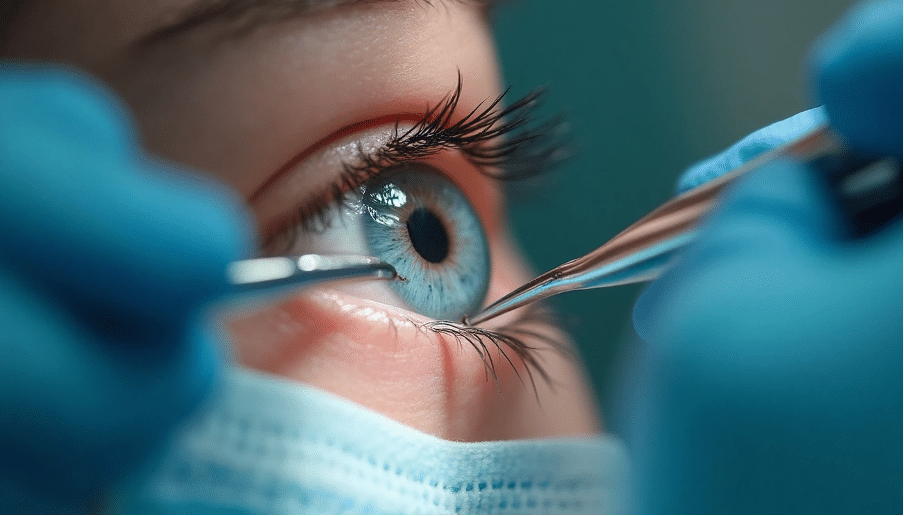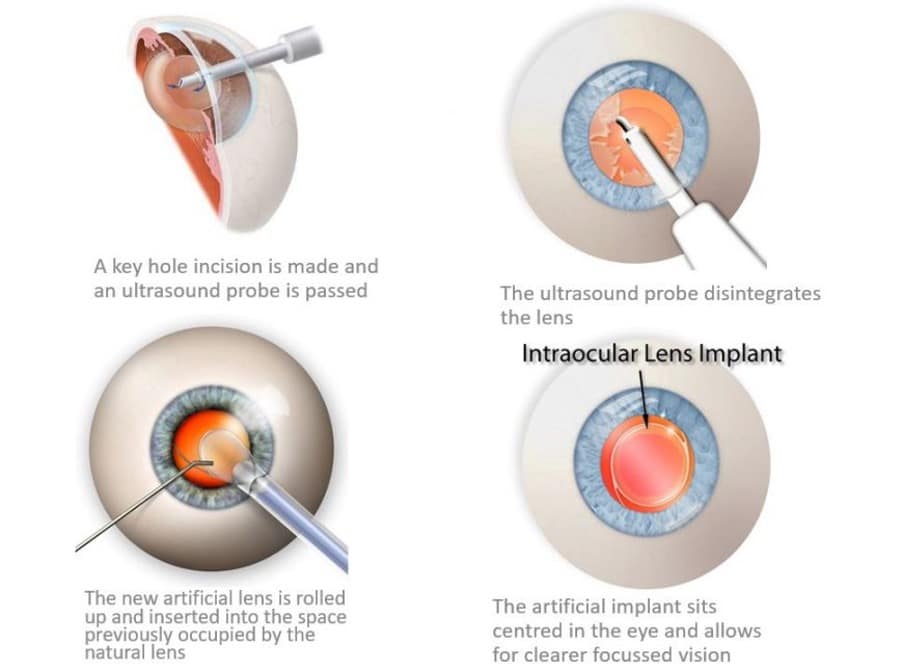The numbers tell an amazing story – eye lens replacement surgery takes only 15 to 30 minutes, and 98% of patients face no serious complications. The surgeon makes a tiny incision – smaller than three millimetres – that needs no stitches to start your lens exchange recovery. Some patients see better the very next day and might not need reading glasses anymore. Most people can get back to their regular routine within one to two weeks after the surgery. The intraocular lens implants become a permanent part of your eyes and last throughout your life.
Your vision might keep getting better for up to six months, though most patients bounce back quickly after the procedure. You might still need glasses to read or see distant objects since your prescription could be different from what it was before surgery.
This detailed guide covers everything about refractive lens exchange recovery – from right after surgery to long-term vision care. It helps you prepare for success with realistic expectations.

Understanding Refractive Lens Exchange
RLE stands as one of the most advanced vision correction procedures that helps adults live without glasses or contact lenses. This breakthrough procedure gives patients long-lasting visual clarity instead of temporary fixes.
What is refractive lens exchange surgery?
RLE surgery removes your eye’s natural crystalline lens and puts in a clear artificial intraocular lens (IOL). The procedure works by building your glasses or contact lens prescription right into your eyes. Each eye takes about 10 minutes to complete, and patients can go home within an hour after treatment. RLE gives a permanent fix for many vision problems, including presbyopia. This age-related decline in near vision affects most people in their 40s.
How it is different from cataract surgery
The surgical technique used in refractive lens exchange is similar to modern cataract surgery. The main difference lies in the lens condition before removal. Cataract surgery removes a cloudy, worn-out lens that blocks vision. RLE removes a clear but faulty natural lens that can’t focus properly at all distances. The main goal of RLE helps reduce dependence on glasses or contact lenses rather than fixing lens cloudiness.
Who is a good candidate for lens replacement
The best candidates for refractive lens exchange are people over 40 who have presbyopia or refractive errors that laser eye surgery can’t fix. The procedure helps correct:
- Short-sightedness (myopia)
- Long-sightedness (hyperopia)
- Astigmatism
- Presbyopia (age-related near vision decline)
People with high glasses prescriptions see great results from this procedure. Some eye conditions might make you unsuitable for RLE. These include corneal disease, age-related macular degeneration, diabetes-related retinopathy, or risk factors for retinal detachment. You need stable vision and healthy eyes to get the best results. RLE can fix almost any level of myopia or hyperopia. Modern IOLs even come with built-in astigmatism correction.

What to Expect During the Procedure
Your trip to better vision starts before the refractive lens exchange procedure. Good preparation will give optimal results and comfort throughout the process.
Pre-surgery preparation and consultation
You’ll first meet an ophthalmologist who will perform a complete eye examination to check if you’re suitable for the procedure. The assessment measures your eye’s shape and size, evaluates your vision, and looks for any conditions that might affect surgical outcomes. Your surgeon will explain various intraocular lens (IOL) options based on your lifestyle, visual needs, and priorities. Think over which activities matter most in your daily life and whether you’d feel comfortable wearing glasses occasionally after surgery.
Step-by-step overview of the surgery
The procedure begins with anaesthetic eye drops to numb your eye’s surface, along with a mild sedative to help you relax. The surgery takes between 15 to 30 minutes per eye. Your surgeon will:
- Make a small self-sealing incision (approximately 2.5mm) where your cornea meets the white of your eye
- Remove a circular disc from the front membrane that covers your natural lens (capsulotomy)
- Use ultrasound technology (phacoemulsification) to break up and remove your natural lens
- Place the chosen IOL through the same incision and position it within your lens capsule
- Apply antibiotics and put a protective shield over your eye
The incision heals naturally without stitches because it’s so small.
Types of replacement eye lenses used
Your surgeon might recommend these options based on your visual needs:
- Monofocal IOLs – Give clear vision at one focal distance (typically distance vision), though you might need reading glasses for close work
- Multifocal IOLs – Provide multiple focusing points for better vision at various distances, which could reduce your need for glasses
- Toric IOLs – Specially designed to fix astigmatism along with nearsightedness or farsightedness
- Extended Depth of Focus (EDOF) – Gives a continuous range of vision from distance to intermediate activities
Each lens type has specific benefits that match your visual needs and lifestyle.
Recovery Timeline and Aftercare
Your refractive lens exchange recovery begins right after the procedure. The healing process takes several weeks while your eyes adapt to their new lenses.
Immediate post-surgery effects
Your vision becomes blurry after surgery as the anaesthetic wears off. The pupil stays dilated for 24-48 hours. You might feel mild discomfort and itching that usually goes away in a day or two.
Recovery time for lens replacement surgery
The eye needs about eight weeks to heal completely. Most patients return to their regular activities within a few days. Recovery usually takes 3-4 days. Any sensitivity and discomfort gradually decrease during this time.
How long does it take for vision to stabilise?
Vision changes are normal in the early weeks as your eyes adjust to the new lenses. Some patients see improvements right away. However, vision typically stabilises within 2-4 weeks.
Using eye drops and protective shields
Your surgeon will give you antibiotic and anti-inflammatory eye drops to prevent infection and reduce swelling. A clear plastic shield protects your healing eye every night for one week. You can remove it during the day.
When to resume daily activities
Your return to regular activities happens step by step:
- Driving: Ask your surgeon about when you can start
- Work: Return to office work after 3-7 days
- Swimming: Wait for two weeks
- Manual work: Safe to resume after two weeks
Want to know what recovery after Refractive Lens Exchange looks like? Precision Vision London helps guide you from surgery day until you achieve full visual clarity. Book your consultation today to begin your trip toward sharper, glasses-free vision.
Managing Risks and Long-Term Vision
Understanding the potential risks after refractive lens exchange will give a lasting visual benefit with minimal complications.
Common side effects and how to handle them
Your vision might become blurry right after surgery. Mild discomfort and eye redness can also occur—these normal symptoms typically improve within days. Prescribed eye drops provide effective relief from temporary eye dryness or grittiness. Visual disturbances like halos around lights or shadows in peripheral vision sometimes occur, especially when you have multifocal lenses. Most patients find comfort knowing these effects decrease over time, and 95% achieve driving standard vision or better.
Posterior capsule opacification and laser treatment
Posterior capsule opacification (PCO) remains the most common long-term complication, affecting 20-50% of patients within five years after surgery. Cell growth over the lens capsule’s back causes cloudy vision. A painless, five-minute outpatient YAG laser capsulotomy safely treats PCO. Most patients’ vision clears within 24 hours after treatment.
When to seek medical advice
Contact your surgeon promptly if you experience:
- Severe eye pain after surgery
- Increasing redness with blurred vision
- Swelling of the eyelids
- Flashing lights or new floaters
- Vision that improves then worsens
These symptoms could indicate rare complications that need immediate attention.
How long do replacement lenses last?
Replacement lenses stay permanently in place throughout your lifetime. They offer advantages over glasses or contacts since they don’t wear out. The largest longitudinal study with 10-15 year follow-ups confirms excellent long-term visual acuity in most patients, barring new eye conditions. Research shows 60% of patients experience only minimal visual changes at the 15-year mark after surgery.
Conclusion
Refractive lens exchange is a remarkable solution that helps people break free from glasses or contact lenses, especially after age 40. This piece explores how a 15-30 minute procedure can change your vision with minimal recovery time and excellent long-term results.
Most patients return to normal activities within days, though complete recovery takes several weeks. Advanced IOL options and a small, self-sealing incision ensure both safety and visual clarity that matches your specific needs. On top of that, these permanent implants provide lifelong benefits, with studies showing excellent vision that stayed strong even 15 years after surgery.
You might experience mild discomfort or blurry vision at first, but these issues typically resolve quickly with proper aftercare. Posterior capsule opacification could develop years later, but a simple laser treatment fixes this easily.
Precision Vision London’s expert surgeons use state-of-the-art technology to deliver outstanding results. They guide patients through each recovery stage with personalised care. The UK’s impressive numbers tell the story – 95% of patients achieve driving standard vision or better after RLE.
Refractive lens exchange could give you the clear, glasses-free vision you want if presbyopia or refractive errors affect your life’s quality. Your path to better vision begins with a consultation where our specialists assess your unique needs and explain all options. Take the first step to sharper vision today – your eyes deserve expert care from a trusted clinic with proven results.
FAQs
Q1. How long does it typically take to recover from refractive lens exchange surgery? Most patients can return to their normal routine within a few days, but complete visual stability usually takes 2-4 weeks. The eye fully heals in approximately eight weeks.
Q2. Will I need to wear glasses after refractive lens exchange? About 80% of patients are completely free from glasses after RLE with modern multifocal intraocular lenses. If you do need glasses, it’s usually for specific activities at near, intermediate, or far distances.
Q3. What are the common side effects after refractive lens exchange? Immediately after surgery, you may experience blurry vision, mild discomfort, and eye redness. These typically improve within days. Some patients may also notice temporary dry eyes or visual disturbances like halos around lights, which generally diminish over time.
Q4. How long do the replacement lenses last? The intraocular lenses used in refractive lens exchange are designed to last a lifetime. They don’t wear out like glasses or contact lenses, and studies show excellent visual acuity maintained even 15 years after surgery.
Q5. What is the success rate of refractive lens exchange? Refractive lens exchange has a high success rate, with studies showing patient satisfaction rates of approximately 90% to 95%. Most patients experience vision improvement within 24 hours of surgery, and about 95% achieve driving standard vision or better.
Authors & Reviewer
-
 Olivia: Author
Olivia: AuthorHi, I'm Olivia, a passionate writer specialising in eye care, vision health, and the latest advancements in optometry. I strive to craft informative and engaging articles that help readers make informed decisions about their eye health. With a keen eye for detail and a commitment to delivering accurate, research-backed content, I aim to educate and inspire through every piece I write.
-
 Dr. CT Pillai: Reviewer
Dr. CT Pillai: ReviewerDr. CT Pillai is a globally recognised ophthalmologist with over 30 years of experience, specialising in refractive surgery and general ophthalmology. Renowned for performing over 50,000 successful laser procedures.

